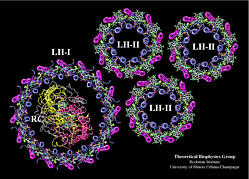Integral Functional Units
|
Genomics, revealing the blueprint of whole organisms, motivates researchers to understand the interplay of many proteins in biological cells. Integral functional units are systems made up of many molecular components that self-assemble, recognize and control each other with the end of performing one overall function. The photosynthetic membrane of purple bacteria, responsible for absorption and conversion of light energy into ATP, as well as the purple membrane, responsible for light-driven pumping of protons in halobacteria, are examples for integral functional units for which all molecular components are structurally known already today. We study the structure-function relationships in such integral functional units with molecular dynamics and quantum mechanics. In addition to the conceptual challenge of understanding the interplay between molecular components, the size of the systems pose severe computational challenges and often require the development of theoretical descriptions with resolutions adapted to the size of the systems. Understanding how integral molecular machines are assembled and how they work together is the next step towards arriving at an understanding of how life comes about through the self-organization of innate matter. |
ATP Synthase
 |
ATP synthase is a large multi-protein complex which includes a transmembrane Fo unit coupled to a solvent-exposed F1 unit via a central stalk. The stalk rotates within the surrounding subunits of F1, leading to cyclic conformational changes in the three catalytic sites in F1 and, thereby, to ATP synthesis. We use steered molecular dynamics to apply a torque to the central stalk in order to understand the cooperative interactions that underlie this mechanism. |
Purple Membrane of Halobacteria
 |
The purple membrane (PM) of halobacterium salinarium consists of
bacteriorhodopsin trimers, lipids and water molecules. Upon light
absorption by the chromophore inside bacteriorhodopsin, protons are
pumped across the PM to the extra-cellular side of the membrane. With
molecular dynamics simulations of the whole PM, we are studying the
influence of the native environment on the protein dynamics.
|
The Photosynthetic Membrane of Purple Bacteria
| Introductory movie available ! |
(25 MB Streaming Video, 6 min, requires RealVideo player) |
| The photosynthetic unit of purple bacteria consists of the
photosynthetic reaction center (RC), surrounded by a core
light-harvesting complex, and additional peripheral light-harvesting
complexes. In the RC, light energy is used to pump an electron through the
membrane. The light-harvesting complexes are pigment-protein complexes
which absorb light and funnel the light energy, in form of electronic
excitations, to the RC. We study how the architecture of this
multi-protein system controls the various excitation transfer
processes occuring in this system of multiple pigment-protein
complexes.
|
 |



